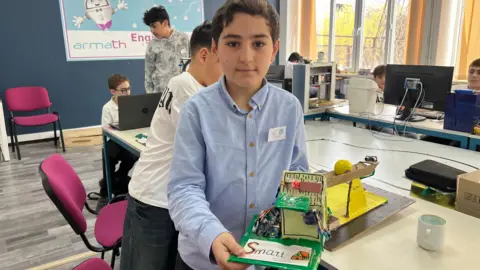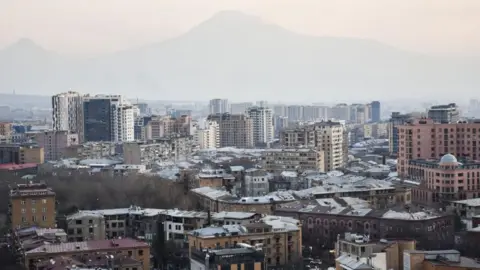
How Armenia is attempting to create a Silicon Valley for the Caucasus
Rayhan Demytrie
BBC South Caucasus correspondent
 BBC
BBC
Young Armenians, such as nine-year-old Slavik, are attending technology classes
In Armenia tech education starts early.
In a typical three-storey state school in the suburbs of Yerevan, the Armenian capital, nine-year old Slavik is demonstrating his invention – a box with three LED lights.
“He has learned how to control it, and the programming language. You can see the code is written by him,” says Maria, the 21-year-old tech coach leading the class.
Next to them, 14-year-old Eric and Narek are showing their smart greenhouse model that monitors temperature and controls fans automatically through a mobile app.
Other children are enthusiastically showcasing their inventions: games, robots, apps and smart home projects.
Eleven-year-old Arakel is holding his cardboard model of a house with a retractable clothesline.
“I have made my mother’s work easy, one part of the device is set on the roof, and another is a motor,” he says. When it rains, the line will go under the roof so that the clothes are kept dry. The program, called Armath (which translates to English as “root”), began in 2014. There are currently 650 Armath labs located throughout Armenia. Today there are 650 Armath labs in schools across Armenia.
The initiative was established by a business organisation called the Union of Advanced Technology Enterprises (UATE), which represents more than 200 high-tech Armenian companies.
“The vision is that we want to see Armenia becoming a tech centre powerhouse that delivers utmost values to Armenia and to the world,” says Sarkis Karapetyan, the chief executive of UATE.
In his spacious, open-plan office in Yerevan he says that there are now around 4,000 tech companies in Armenia.
Getty Images
Armenia and its capital Yerevan, pictured, were a centre of maths and computing during the Soviet era

Armath is part of the UATE’s education programme.
Mr Karapetyan claims that the program is the most successful private-public partnership in the nation.
We raise capital expenditures from the business sector, then we go into the schools to establish Armath laboratories, we donate equipment,” he said. The education ministry provides us with a budget of $1.5 million (£2m) per year to pay for the salaries of coaches. “
There are now more than 600 coaches, and 17,000 active students.
“The goal is to have 5,000 of the most talented kids decide to become engineers every year,” says Mr Karapetyan.
Armenia is a landlocked country of 2.7 million people, the smallest in the South Caucasus region, and its borders with neighbouring Azerbaijan and Turkey have been shut for decades due to unresolved territorial disputes.
Unlike its neighbours, Armenia does not have natural resources or access to the sea. But throughout the Soviet era it had been a centre of mathematics and computer science.
In 1956 the Yerevan Scientific Research Institute of Mathematical Machines was established in Armenia and by 1960 it had developed two first generation computers.
Today, the country is tapping into its legacy with the ambition to transform itself into the tech powerhouse of the Caucasus.
And there has been some success already. Picsart is a photo and video editing app and website powered by AI that was launched in Armenia back in 2011. Today the company of the same name, which has dual headquarters in Yerevan and Miami, is valued at $1.5bn.
Krisp, which makes audio-processing software, and Service Titan, which provides business software, are other Armenian success stories.
Meanwhile, an annual report says that Armenia is the best country in the Caucuses region in which to launch a company, putting it in 57th place globally. Georgia is ranked 70th, while Azerbaijan is ranked 80th.

Picsart, founded in Armenia in 2011, is today valued at $1.5bn
A critical factor in boosting Armenia’s tech development is the nation’s global diaspora – some 75% of the world’s estimated Armenians, and people of Armenian descent, live elsewhere.
This worldwide community provides important connections, especially in the US tech industry. In the US there are as many as 1.6 million people of Armenian ancestry, centred on California.
Samvel Khachikyan, is director of programs at SmartGate, a venture capital firm based in both California and Armenia that focuses on tech investments.
He says that if you look at the top 500 companies in the US, “for sure you’ll find at least one or two Armenians” in the boardroom or one management level below.
Mr Khachikyan explains how his company helps Armenian entrepreneurs set up operations in the US.
“Imagine an Armenian start-up, two young people deciding to go to the US to try to operate there, they have no connections, no knowledge about the culture how it works.
“It’s gonna be hard, very hard. It’s hard to launch a rocket. The first few seconds are the most difficult. “
SmartGate takes Armenian founders to Silicon Valley and Los Angeles for intensive networking with top US companies and investors.
But many Armenian start-ups first test their products in their home market.
Irina Ghazaryan, is the founder of an app called Dr Yan that is changing how Armenians access healthcare by enabling them to more easily book appointments with doctors.
Ms Ghazaryan was previously working in product and web design when, helped by the fact she comes from a family of doctors, she identified a gap in the market. Patients couldn’t find doctors and doctors had to deal with endless calls. The app is based on a subscription-based model where doctors pay to be listed. There are plans to expand. We are close to breaking even in Armenia, and this gives us the strength to expand to other markets like Uzbekistan. “
Irina Ghazaryan plans to expand her medical app Dr Yan abroad
Armenia’s tech ecosystem received an unexpected boost in 2022 following Russia’s invasion of Ukraine. Thousands of Russian IT specialists left their country, and many chose to settle in Armenia.
Meanwhile, US chipmaking giant Nvidia moved its Russian office to Armenia.
Vasily is a Russian IT consultant who relocated to Armenia in 2023. He says that Armenia was the friendliest country to Russians in order to assist them in moving, adapting and so on. This influx has said to have filled crucial skill gaps in Armenia’s tech sector, in areas such as data processing, cybersecurity, and financial technologies.
Yet Vasily says that Armenia can be expensive and the country needs to reduce the tax burden on IT firms if it wants them to stay in the country.
However, overall optimism remains high about Armenia’s tech future. Samvel Khachikyan believes the tech sector will boom. He cites Service Titan as an example, which was listed on the New York Stock Exchange in December and is worth over $10bn.


